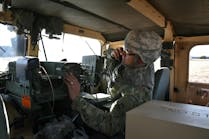By John Keller
FORT MONMOUTH, N.J. - The quality of commercial off-the-shelf (COTS) plastic encapsulated microcircuits (PEMs) today is at least as good - and in many cases better - than equivalent parts built to military specifications, claims a U.S. Army reliability expert.
In fact it is a myth that mil-approved microcircuits are at all superior to COTS PEMs, claims Edward Hakim, team leader for component reliability at the Army Research Laboratory at Fort Monmouth, N.J.
Hakim, an outspoken proponent of COTS, conducted a survey of 16 defense and commercial integrators and subsystem manufacturers last May, and to his surprise found that none of them reported any advantage in using mil-approved parts.
"I expected the mil-approved parts to have more champions, or at least have some justification for using them," Hakim says. "It was totally unexpected that all the respondents did not see any advantage in using mil-approved parts; in fact, they say there is a disadvantage."
The defense contractors Hakim contacted for the survey were ITT Corp. of Fort Wayne, Ind.; Alliant TechSystems of Hopkins, Minn.; Litton Industries of Woodland Hills, Calif.; Rockwell International Corp. (now Boeing North American Inc.) of Anaheim, Calif.; Group Technologies of Tampa, Fla.; Honeywell of Minneapolis; Texas Instruments of Dallas; NFT-Ericsson of Norway; Hughes Aircraft Co. of Los Angles; and one unnamed company.
The commercial contractors Hakim contacted were Delco of Kokomo, Ind.; tandem Computers of Cupertino, Calif.; United Technologies of Hartford, Conn.; Unisys (now Lockheed Martin) of Eagan, Minn.; Honeywell of Minneapolis; and one unnamed company.
Systems using PEMs, Hakim found, included the ITT Single Channel Ground and Airborne Radio System, better known as SINCGARS; the McDonnell Douglas C-17 airlifter; and the Texas Instruments Javelin anti-tank missile.
The systems environments in which designers use PEMs that Hakim included in the survey range in temperature from -55 to 95 degrees Celsius, with relative humidity readings between 40 percent and 100 percent.
Hakim says his respondents reported a commercial vs. mil device cost savings of between 6 percent and 100 percent, with an average device savings of 37 percent. System cost savings from using PEMs range from $200,000 to $94 million, with a reduction in weight, size, assembly reject rate, and improved reliability.
"That survey says that people who have gone through the exercise believe that commercial parts have advantages at the device level because they cost less, have better delivery schedules, can be surface mounted rather than through-hole," Hakim says. "At the system level the systems are smaller, lighter, and from the numbers we are seeing, the reliability is better."
Increased reliability of PEMs results from sheer numbers, Hakim says. "The commercial parts are coming off lines generating millions of parts a month to demanding customers," he says. "It is very competitive our there, so they have to have good yield and very few fallouts from the line. Mil parts have fewer customers and have problems with process control because they are not continuously running lines."


